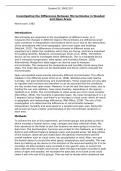Student ID: 30821207
Investigating the Differences Between Microclimates in Wooded
and Open Areas
Word count: 1982
Introduction
Microclimates are important in the investigation of different areas, as it
measures the changes in different regions. Microclimates are defined as small
scale variations in temperature and moisture which occur due to the interactions
of the atmosphere with local topography, land cover types and buildings
(MetLink, 2017). The differences of microclimates in different areas are
important as it states the conditions which they are facing, and hence important
for building facilities, fieldwork, and practicals (Chen et al, 1993). The Kestrel
device can be used to investigate these differences. This is a handheld device
and it measures temperature, wind speed, and humidity (Kestrel, 2020).
Alternatively, MadgeTech data logger can also be used to measure
microclimates. This measures the temperature and humidity trends along time
steps. The large data sets can be downloaded and hence used to evaluate the
microclimates.
Open and wooded areas provide extremely different microclimates. This affects
habitats in the different areas (Chen et al, 1999). Wooded areas hold relative
humidity, rich plant biodiversity and invertebrates. These organisms are less able
to regulate their moisture and therefore it can be assumed that the conditions
are less severe than open areas. However, it can be said that open areas, due to
holding the sun and radiation, have more diversity- depending on the species
(Seibold et al. 2016). The microclimates in urban areas are much more complex
(Met Office, 2018). The humidity is generally lower, the mean temperature is 1 or
2 degrees Celsius higher, and there is an increase in cloud cover, which all result
in geography and meteorology differences (Met Office, 2018). The aim of this
investigation is to determine the differences in microclimates between
temperature, humidity and wind speed in a wooded and open area. Doing this
will ensure we have a better understanding of the microclimate variations in
each area.
Methods
To achieve the aim of this experiment, we formed groups and picked up the kit,
which included a kestrel device, map, compass and data collection sheet. We
then advanced to the fields to pick the locations we were going to record our
data from. The Southampton Common was picked for this fieldwork, as it holds a
distinct and sufficient balance between open and wooded areas. We took photos
of the location, observed and noted down the general environment and the
overall weather such as cloud cover, any precipitation or wind. After, we used
the kestrel device to record the wind speed, temperature and humidity. This was
done by holding up the device to the direction of the wind and waiting for it to be
recorded. 20 data numbers were recorded in one specific area, to ensure the
data collected was reliable and concise. After the data had been recorded in both
areas of open and wooded, we recorded the data sets on to Excel so we could
share it with the rest of the groups. Then we had to decide which statistical test
, Student ID: 30821207
we would use to compare the two areas of microclimates. The two tailed T test is
the clear choice, as it takes in account areas with different factors (Davis et al,
2010). My group decided to use Excel and SPSS to extend reliability of our results
and ensure that we have accurate data sets and a valid overall conclusion.
Figure 1: The red cross shows the spatial view of the open area which recorded
data was taken. (GoogleMaps, 2020)
Figure 2: The red cross shows the spatial view of the wooded area which recorded
data was taken. (GoogleMaps, 2020)




